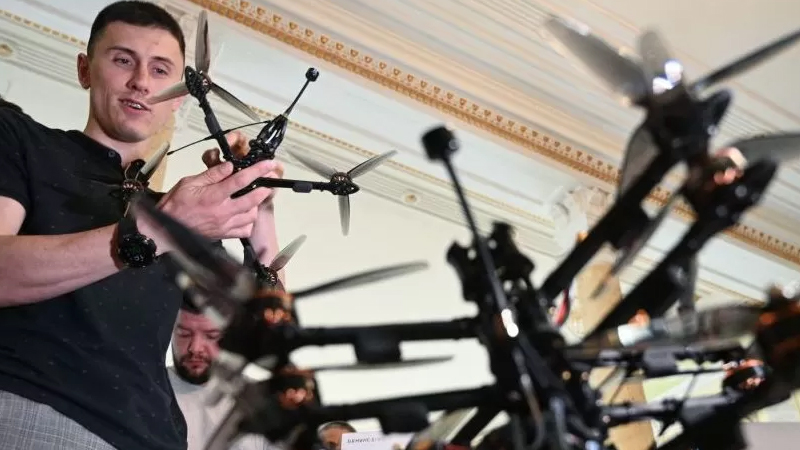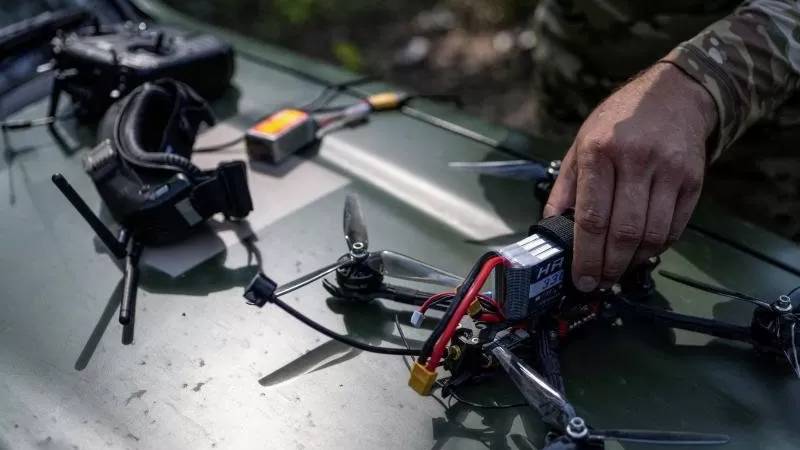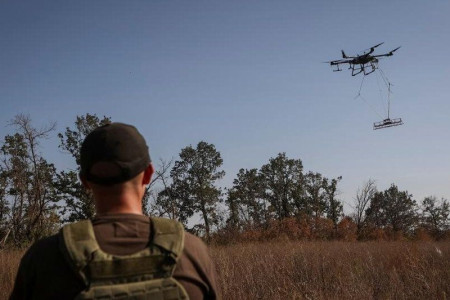Many of them are commercially made in China and bought off the shelf, and new supplies are vital because of the large numbers lost in the fighting.
But there are indications of a reduction in the number of Chinese drones and parts available to both Ukraine and Russia.
According to the Royal United Services Institute (Rusi), a London-based think tank, Ukraine is losing about 10,000 drones a month.
Numerous volunteer groups have been instrumental in using donated funds to help the Ukrainian army restock its supplies.
Commercial drones are used alongside purpose-made military designs, such as Turkish Bayraktar drones used by Ukraine and Iranian Shaheds used by Russia.
The latest restrictions imposed by the Chinese government came into force on 1 September. They apply to longer-range drones weighing more than 4kg, as well as drone-related equipment such as some cameras and radio modules.
Chinese producers of such equipment are now required to apply for export licences and provide end-user certificates, and the government in Beijing - which has not condemned Russia's invasion of Ukraine - says commercial Chinese drones must not be used for military purposes.
Ukrainian volunteers and soldiers say the latest Chinese restrictions have so far had minimal impact on the availability of drones, especially the ubiquitous lightweight Mavics made by the Chinese company DJI.
 Ukraine has been relying on DJI Mavic drones for its defence against Russia's invasion
Ukraine has been relying on DJI Mavic drones for its defence against Russia's invasion
However, they say that the supply of parts has been affected, and they also fear that the situation may worsen in the future.
"The only change for now is that we're more actively buying whatever stock is left in European warehouses," says Lyuba Shypovych, who heads Dignitas, one of the largest Ukrainian volunteer groups supplying the military with drones. "But what we'll be doing in the future is unclear."
She is particularly worried about the availability of parts such as thermal imaging cameras.
"Because days are getting shorter and nights longer, this is definitely having an impact on supplies for our military and on how warfare is conducted in general because we don't have as many thermal imaging drones. Our units are turning blind at night," she says. "This affects both off-the-shelf drones with thermal imaging cameras and parts."
The availability of parts is particularly important for those who assemble their own drones or improve purchased models.
"The impact is being felt. The licences required by China now have limited Ukraine's access to drone parts," says a senior drone operator from the Kastus Kalinouski regiment who uses the callsign Oddr. "But we're looking for alternatives to make sure our drones work as they did before."
This is just the latest hurdle facing volunteers procuring drones for both the Russian and Ukrainian armies.
 Some volunteers say the Chinese restrictions may stimulate the production of drone parts back in Ukraine
Some volunteers say the Chinese restrictions may stimulate the production of drone parts back in Ukraine
The world's largest commercial drone-maker, DJI, halted direct sales to both countries two months after the start of the full-scale invasion in February 2022. It also banned its distributors across the globe from selling DJI products to customers in Russia or Ukraine.
According to Ms Shypovych, the number of Chinese drones made available to distributors in Europe fell sharply between August and September 2022.
"It's unlikely that it happened by chance. European countries are where Ukrainians import drones from," she says.
When contacted by the BBC, DJI could not confirm or deny any changes in the number of drones available to distributors in Europe.
None of the 10 companies selling DJI products in the UK and approached by the BBC were available to comment on the issue either.
An investigation by The New York Times found that Chinese companies have in recent months cut back sales of drones and components to Ukrainians.
But it is not just Ukraine that is affected.
Referring to the curbs that came into force on 1 September, Russian newspaper Kommersant, said: "The restrictions imposed by the Chinese authorities on drone exports have seriously complicated their supplies to Russia and led to a shortage of some parts, such as thermal imaging cameras."
In the absence of direct supplies, buyers from Russia often shop for Chinese drones in countries like Kazakhstan, and, according to Kommersant, the Central Asian state has further complicated things for them by tightening its own drone import regulations.
To minimise the impact of the Chinese restrictions, Ukrainian volunteers have been busy looking for alternatives made in other countries - both in the West and Ukraine itself.
Anatoly Polkovnikov, who helps procure drones, says that a Ukrainian start-up is preparing to launch the production of drone motors.
He says he is optimistic about the future: "I don't think these Chinese restrictions will have any impact on the general situation. I have the feeling that long-term they will stimulate production in Ukraine."
The war in Ukraine is the first armed conflict in which drones have been used so extensively and in such great numbers, and both of the warring sides are determined to keep it that way.
By Vitaly Shevchenko
BBC Monitoring


